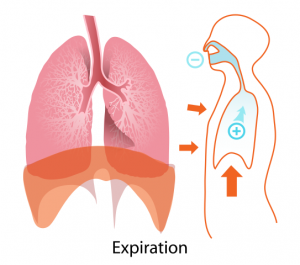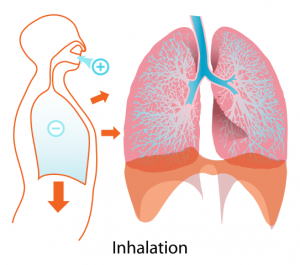The Basic Mechanics of Breathing
Oxygen (O2) is the food of the human body. Every cell in your body requires oxygen to create energy and carry out its various functions. On the other hand, carbon dioxide (CO2) is the garbage of the human body that every cell creates as a byproduct of its functions. It is common knowledge that the lungs are the organ that take the oxygen from the air and bring it into the body and conversely expel (exhale) CO2 at the same time. This process of taking in oxygen and getting rid of CO2 occurs with every breath.
There are two parts of every breath:
- inspiration (also called inhalation) and
- expiration (also called exhalation)
During inspiration, your body takes in the air. Normal ambient air is made up of approximately 78% nitrogen and 21% oxygen, as well as a small amount of various other trace gases. This amount of oxygen is more than adequate for healthy lungs to take in and circulate through the body for normal daily activities.
But what is the mechanism that triggers a breath to happen, and how exactly does this exchange occur?
The human body has a specific baseline amount of oxygen that it must have in order to function. It also has a maximum level of carbon dioxide that it is comfortable with keeping in the body at any given time. At any point, if the level of O2 drops below, or the level of CO2 climbs higher than, the body’s favoured level, the brain kicks in and asks the lungs to breathe in more oxygen or breathe out more CO2.
Key Takeaways
The brain is the trigger that initiates a breath based on the body’s “set baseline” for oxygen need or carbon dioxide (CO2) removal.
How does this happen? The central nervous system has chemoreceptors that sense the levels of oxygen and carbon dioxide in the body. This sensing is done independent of each other. The central chemoreceptors measure the level of carbon dioxide, and when it gets too high or low, will trigger the brain to adjust how the body is breathing. Remember: the human body exhales CO2 so if the central chemoreceptors measure that levels of carbon dioxide are too high in the blood, then they send a message that the body needs to breathe out more carbon dioxide. Conversely, the peripheral chemoreceptors are responsible for sensing the oxygen levels. If the blood levels of oxygen drop, this will send a message that the body needs to breathe in more oxygen. This signal will trigger a breath.
Apply Your Learning
Why does your body breathe faster when you are doing cardiovascular exercise? What chemoreceptors are involved in this process?
When a message or “trigger” occurs by the chemoreceptors sensing a need for a breath, the brain asks for the breath by stimulating the diaphragm to contract. The diaphragm is the large muscle that lines the bottom of the lungs. In this animation, the diaphragm, located below the two lungs, is red and the lungs are blue.
GIF via Gfycat
The diaphragm is “glued” to the bottom of the lungs by the pleural space so that when the diaphragm contracts, this pulls the lungs down and open.
Object Lesson

Think of pulling open an accordion. As you pull on the end of the accordion, it gets bigger and fills with air.
It is important to understand this concept as it relates to pressure and volume in the lungs. As the diaphragm contracts and pulls the lungs open, it results in a vacuum state in the lungs—negative pressure. Just like a vacuum, it sucks air into itself. That negative pressure in the lungs causes air to passively flow into the lungs as long as that negative pressure exists.
Object Lesson

Think of a slinky with one end in each hand. When one hand is placed lower than the other, the slinky falls towards it. When you move the other hand lower, the slinky falls in the other direction. In the same way, when there is lower/more negative pressure in lungs, the air rushes in until the pressure is equal or becomes higher in the lungs—then, the air exits the lungs.
Key Takeaways
If there is a negative pressure in a space, air will naturally flow to fill this space. Just like water flowing downstream, air always flows from higher pressure to lower pressure.
So how does air stop flowing into the lungs? Once the lungs sufficiently fill—based on the amount of air that the brain has decided it requires to satisfy its need—it turns “off” the diaphragm. Contraction stops and the muscle relaxes. The diaphragm is no longer pulling the lungs open. The vacuum has turned off and the negative pressure has subsided. It’s important to remember that the lungs are full of air at this point. Air has been passively filling them for a while.
Object Lessons

Lungs act like balloons. When no other force is acting on them, the surface of each alveolus has a tension to it—exactly like a rubber outside of an inflated balloon. When nothing stops it, the lung naturally wants to empty, just like the elastic recoil of a balloon that isn’t tied and is allowed to leak.

A great example of the natural mechanics of the lungs is an archer’s bow. The diaphragm actively pulls the lungs open like the hand on the back of the bow. As soon as that active force stops, the elastic recoil of the bow kicks in and resets it back to its relaxed state.
This collapsive force is accomplished by surface tension and is identical to what you notice with balloons. The fuller the balloon is, the higher the tension wanting the balloon to shrink.
Thinking back to the flow of air related to pressure, at the beginning of exhalation when the lungs are full and the surface tension of the lungs is wanting to collapse the lungs, there is high positive pressure in the lungs. Think of how high the pressure gets in a balloon when it is full. Remember, air always flows from high to low pressure, so the air flows out of the lungs (exhalation).
Key Takeaways
The lungs act exactly like balloons when no outside force is acting (i.e., surface tension when full of air, or being pulled open by the diaphragm) on them or stopping them, they passively will want to deflate.
To summarize, the cascade of breath in and out is all about the flow of air from HIGH to LOW pressures. It starts in inspiration, with the lungs having a negative (lower) pressure from the diaphragm contracting. Air flows in until the diaphragm stops contracting, which stops that negative pressure. Inspiration stops. At this point, the lungs are full of air and are experiencing a higher pressure than the outside world. Exhalation starts as air flows from high to low pressure once again.


Thinking of balloons and Slinkys, the likely conclusion is that this passive flow of air out of the lungs (exhalation) would continue until the pressures have equalized. This is true of balloons but does not occur in the human body because of one very important principle: intrinsic PEEP. We’ll learn all about this on the next page.
Media Attributions
- expiration © LadyofHats via Wikimedia Commons is licensed under a Public Domain license
- inhalation © LadyofHats via Wikimedia Commons is licensed under a Public Domain license

